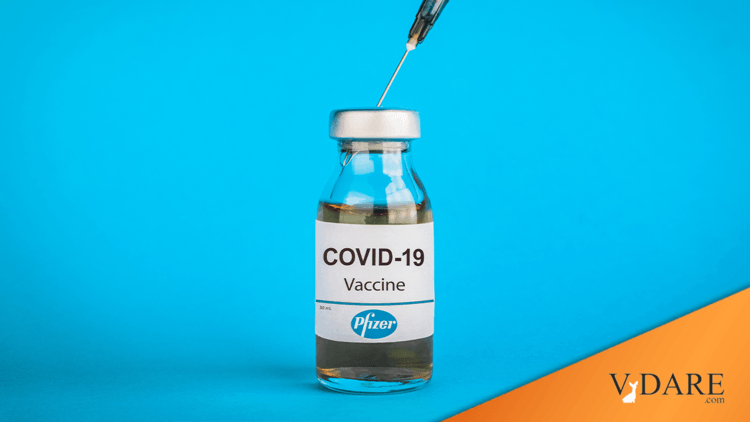From a Pfizer press release:
PFIZER AND BIONTECH ANNOUNCE VACCINE CANDIDATE AGAINST COVID-19 ACHIEVED SUCCESS IN FIRST INTERIM ANALYSIS FROM PHASE 3 STUDY
Monday, November 09, 2020 – 06:45amVaccine candidate was found to be more than 90% effective in preventing COVID-19 in participants without evidence of prior SARS-CoV-2 infection in the first interim efficacy analysis
“More than 90% effective” is huge. The FDA’s cutoff for approval is 50%.
90% effectiveness should be able to crush R-nought and bring about herd immunity in many places in 2021.
If it’s 90% effective, it’s not just that your chance of being infected by each person you meet who is infected goes down 90%, it’s also the chance that somebody you meet is infected goes down as well.
Analysis evaluated 94 confirmed cases of COVID-19 in trial participants
Study enrolled 43,538 participants, with 42% having diverse backgrounds, and no serious safety concerns have been observed; Safety and additional efficacy data continue to be collected
Submission for Emergency Use Authorization (EUA) to the U.S. Food and Drug Administration (FDA) planned for soon after the required safety milestone is achieved, which is currently expected to occur in the third week of November
Clinical trial to continue through to final analysis at 164 confirmed cases in order to collect further data and characterize the vaccine candidate’s performance against other study endpoints
This press release features multimedia. View the full release here: https://www.businesswire.com/news/home/20201109005539/en/
NEW YORK & MAINZ, GERMANY–(BUSINESS WIRE)– Pfizer Inc. (NYSE: PFE) and BioNTech SE (Nasdaq: BNTX) today announced their mRNA-based vaccine candidate, BNT162b2, against SARS-CoV-2 has demonstrated evidence of efficacy against COVID-19 in participants without prior evidence of SARS-CoV-2 infection, based on the first interim efficacy analysis conducted on November 8, 2020 by an external, independent Data Monitoring Committee (DMC) from the Phase 3 clinical study.
After discussion with the FDA, the companies recently elected to drop the 32-case interim analysis and conduct the first interim analysis at a minimum of 62 cases. Upon the conclusion of those discussions, the evaluable case count reached 94 and the DMC performed its first analysis on all cases.
It would be interesting to know when the old 32-case milestone was reached …
I’m guessing that it was decided that 32 cases were not enough for a statistical evaluation of a marginal vaccine that was only 50% effective. But what about this vaccine that is over 90% effective? In hindsight, it looks like a statistically significant result might well have been announceable in October.
For example, say that equal numbers of people were given either the vaccine or the placebo, and out of the first 32 infections among participants, 22 got the placebo and 10 got the vaccine. If so, then your single best guess is that that vaccine would be a little over 50% effective, but, wow, it’s a really small sample size to be confident it’s at least 50%. The margin of error is huge.
In contrast, say that for Pfizer’s vaccine, out of the first 32 infected, 30 got the placebo and 2 got the vaccine (in line with their finding from the first 94 cases of over 90% effectiveness). What are the chances in that example of the effectiveness of the vaccine being at least 50%. Really good.
So, I wouldn’t be surprised that if they’d stuck to the original plan to evaluate at 32 cases, they could have released a statistically significant result in, say, October.
The case split between vaccinated individuals and those who received the placebo indicates a vaccine efficacy rate above 90%, at 7 days after the second dose. This means that protection is achieved 28 days after the initiation of the vaccination, which consists of a 2-dose schedule.
So, basically, this particular vaccine takes a month to be effective: if your first dose is scheduled for March 1, you should be good by April 1, that kind of thing.
The Trump Administration made a deal with Pfizer to buy 50 million double doses for $39 per person.
I believe this vaccine requires hyper-refrigeration, which makes it logistically difficult. But its success boosts the likelihood that easier-to-administer vaccines like Moderna’s might also work.
As the study continues, the final vaccine efficacy percentage may vary. The DMC has not reported any serious safety concerns and recommends that the study continue to collect additional safety and efficacy data as planned. The data will be discussed with regulatory authorities worldwide. …
The Phase 3 clinical trial of BNT162b2 began on July 27 and has enrolled 43,538 participants to date, 38,955 of whom have received a second dose of the vaccine candidate as of November 8, 2020. Approximately 42% of global participants and 30% of U.S. participants have racially and ethnically diverse backgrounds. The trial is continuing to enroll and is expected to continue through the final analysis when a total of 164 confirmed COVID-19 cases have accrued. …
Based on current projections we expect to produce globally up to 50 million vaccine doses in 2020 and up to 1.3 billion doses in 2021.
Pfizer and BioNTech plan to submit data from the full Phase 3 trial for scientific peer-review publication.
Where does Joe Biden fall on the vaccine priority list?













